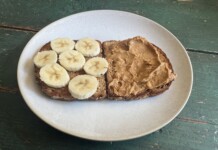By Katherine A. Beals, PhD, RD, FACSM, CSSD and Breanne Nalder, MS, RDN —
In the last article, we covered the role of protein in athletes’ diets as well as recommendations for protein intake for training and competition. But what about those athletes who limit or restrict meats or other animal proteins from their diet? How can they meet their protein requirements? Well, it really is not as hard as you might think (or some glorified and unqualified “nutritionists” might have you believe). Most athletes can, and do, get adequate amounts of protein on a plant-based diet and, assuming the amount and timing of protein intake is appropriate and energy intake is sufficient, athletic performance will not suffer. Read on to find out more about adopting a plant-based diet.

Types of Vegetarianism
The term “vegetarian” generally denotes an individual who limits or restricts animal products in one form or another from his or her diet. Which animal product(s) and the degree of restriction can be highly variable. Below are some of the more common “types” of vegetarians.
- Lacto-ovo vegetarian: is the most common form of vegetarian. Lacto-ovo vegetarians do not eat beef, pork, poultry, fish, shellfish or animal flesh of any kind, but do eat eggs and dairy products (“lacto” comes from the Latin for milk, and “ovo” for egg).
- Lacto vegetarian: is used to describe a vegetarian who does not eat eggs, but does eat dairy products.
- Ovo vegetarian: refers to those who do not eat meat or dairy products but do eat eggs.
- Pesco or Pescatarian: is not an official term but, is occasionally used to describe those who abstain from eating all meat and animal flesh with the exception of fish.
- Semi-vegetarian or “flexitarian”: is the least strict of the vegetarians, this term is used to describe those who eat a mostly vegetarian diet, but occasionally eat meat.
- Vegan: is the most strict of the vegetarians. They don’t eat meat of any kind and also do not eat eggs, dairy products, or processed foods containing these or other animal-derived ingredients such as gelatin. Many vegans also refrain from eating foods that are made using animal products that may not contain animal products in the finished process, such as sugar and some wines. There is some debate as to whether certain foods, such as honey, fit into a vegan diet.
Reasons to (and not to) become Vegetarian
People choose to follow a vegetarian diet for a number of reasons; however, the two most common are because of moral/ethical beliefs (i.e., animal rights, sustainability) and for the purported health benefits a plant-based diet might provide.
Of the two, health benefits are probably the least well-supported by scientific research. While several epidemiological studies have shown an “association” between a vegetarian “lifestyle” and decreased incidence of certain chronic diseases; these types of studies cannot prove causation, rather they can only demonstrate a relationship or a link. There could very well be other mediating factors that are responsible for the “link” or that might be confounding the association.
For example, the vegetarian “lifestyle” tends to be healthier overall (i.e., vegetarians are less apt to smoke, more apt to physically active, less likely to be overweight); thus, it is hard to tease out in these studies whether it is the diet or some other aspect of the vegetarian lifestyle that is providing the health benefits. Nonetheless, there is no question that, from an ecological standpoint, a vegetarian diet is infinitely superior.
Meeting Protein Needs as a Vegetarian Athlete
There is a prevailing misconception that plant sources of protein are “lower quality” sources of protein compared to animal sources of protein because plant proteins are missing one or more essential amino acid. That is completely untrue!
In fact, ALL grain and vegetable proteins contain ALL nine essential amino acids. Fruits provide insignificant amounts of protein overall and, so, their amino acid profiles really aren’t relevant. And as long as we are myth-busting, it is also not true that you have to combine plant sources of proteins at a meal (or anytime really) in order to receive all the essential amino acids. If all grains and all vegetables contain all nine essential amino acids then there is no need to combine plant proteins.
So, where did these misconceptions come from? Well, nutrition scientists have long been interested in examining protein requirements and have derived a number of methods to evaluate proteins for their ability to promote/sustain growth. One of the most popular methods is known as amino acid scoring in which the essential amino acid profile of a food of interest (e.g., a potato) is compared to the essential amino acid profile of a “reference” food (which is typically an egg).
So, if you compare the essential amino acid profile of egg protein to a plant protein you will find that there are some essential amino acids that are found in lower amounts in the plant protein compared to the egg protein; thus, it is considered lower quality compared to an egg. (What they don’t point out is that, in some plant foods there are higher amounts of certain essential amino acids than in eggs—Go figure!).
In any case, such a comparison is misleading and overlooks the point that no one is likely to consume a diet containing only one specific plant food (i.e., potatoes) or one specific animal food (i.e., eggs) for that matter. A nutrient dense-plant based diet containing a wide variety of plant foods and adequate calories to support energy needs will almost always provide sufficient amounts of protein!
Other Nutrients of Concern for Vegetarian Athletes
There are some micronutrients that are found in significantly greater quantities in animal products and, thus, they might be absent or limited in the diet of an individual who chooses to follow a plant-based diet, these include iron, zinc, calcium, vitamin B12 and vitamin D.
Of greatest concern for the cyclist is iron. Found in significant amounts in only a few foods (and poorly absorbed from plant foods), iron is an integral part of hemoglobin, which is essential for oxygen uptake and transport to the working muscle. Iron also functions in energy production and oxidative metabolism, thus rendering it a key nutrient in athletic performance. Endurance athletes such as cyclists are already at an increased risk of iron deficiency due to prolonged phases of intense exercise, muscular injuries, increased turnover of red blood cells, and increased loss of iron in sweat and urine. Red meats provide the most significant and most bioavailable source of iron; thus, anyone who limits or eliminates meats is at increased risk for iron deficiency and should strive to include iron-rich plant foods in their diet (see examples of protein and iron-rich plant foods below).
Going Meat Free
Here are some tips for incorporating more plant-based proteins into your diet while maintaining adequate nutrients and energy needs:
- Build meals around plant sources of protein that are naturally low in fat and high in nutrients, such as beans, lentils, and soy products (tofu, tempeh, edamame beans, etc.)
- Try different veggie versions. A variety of vegetarian products look (and may taste) like their non-vegetarian counterparts, but are usually lower in saturated fat and contain no cholesterol. For breakfast, try soy-based sausage patties or links. For dinner, rather than hamburgers, try veggie/black bean burgers or portabella mushrooms, etc.
- Bone up on sources of Calcium and Vitamin D. Sources include fortified cereals, soy products, calcium-fortified orange juice, and dark-green leafy vegetables. Some may choose to use supplements to get their daily need of the bone builders.
- To help meet vitamin E recommendations, choose specific nut and seed choices such as sunflower seeds, almonds, and hazelnuts.
- Include beans and peas. Due to their high nutrient content, consuming dry beans and peas is recommended for everyone, vegetarians and non-vegetarians alike. Enjoy some beans and rice, a three bean salad, chili, or split pea soup.
- Make some small changes at restaurants. Most restaurants can accommodate vegetarian modifications to menu items by substituting meatless sauces, omitting meat from stir-fries, and adding vegetables or pasta in place of meat.
- Nuts and nut butters make great snacks on salads, or in main dishes. Use nuts to replace meat or poultry, even in sandwiches. Add walnuts or pecans to a green salad instead of cheese or meat.
- Make simple changes from meat products, which can increase vegetable intake and cut saturated fat and cholesterol intake. For example, pasta with marinara or pesto sauce, veggie pizza, vegetable lasagna, tofu-vegetable stir fry, bean burritos, etc. Try veggie/garden burgers, soy hot dogs, marinated tofu or tempeh, and veggie kabobs. Grilled veggies are great, too!
Next week, we will discuss protein supplements. Are they necessary or beneficial? Which type or types are the best? And, are there any potential hazards associated with consuming them?
Read Part 1 and Part 3 of this Series.
Katherine Beals, PhD, RD, FACSM, CSSD is an associate professor (clinical) in the Division of Nutrition at the University of Utah. She is a registered dietitian, a certified specialist in sports dietetics and a fellow of the American College of Sports Medicine.












